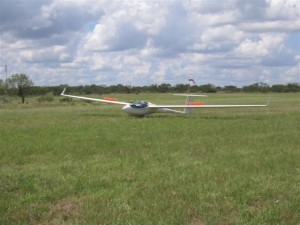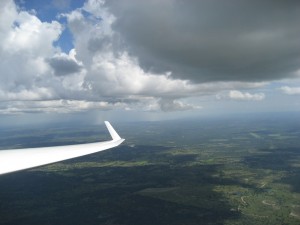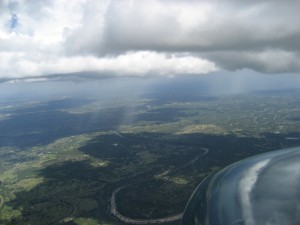After having flown for five years in Texas weather I want to share some thoughts on the soaring conditions in Austin, Central Texas. You hear a lot of stories about the amazing weather conditions in Texas and data from the World Gliding Championships in Uvalde and Marfa confirm the common perception of our outstanding soaring conditions in Texas.
Having sampled the weather myself over the last couple of years I have to say though while good, the conditions aren’t as homogeneous as one might think. There’s a reason for the local saying: Don’t like the weather? Check back in 10 minutes.

Thermals usually coexist with high winds conditions and form in warm air advection with winds shifting clockwise with altitude. In Germany the most comparable weather situation would be a high pressure sytem over the Balkan generating south-easterly winds. Winds play a major role in how the day will develop. We usually start with an overcast cloud layer in the morning from the sea breeze. With winds from 150-170 degrees at 5-15kts you can expect the day to develop into great soaring conditions. I’ve woken up to rain out of an overcast sky. By the time I had reached the airfield the sky started to clear up and an hour later I was on my way for a 500km task, which I finished averaging 108km/h. Cloud base will start low at about 3-4000ft MSL and will rise over the day to 7000ft AGL on a good, 9000ft on an exceptional day. Our airfield elevation is 1200ft. Forecasted maximum temperatures are usually directly proportional to cloud base heights. Due to the warm advection nature of the air mass, temperature is king and thermal activity rarely starts before 11:30a. Lift weakens significantly after 5p and lasts until 7pm on a good day in August, until 7:30p on an exceptional day (usually with a disturbance – mostly high level troughs). Thanks to the winds we often enjoy cloud streets that line up north-south. Unfortunately the nice looking clouds aren’t all very reliable and present wide variations of climb rates while not looking very different from each other. Due to the warm air advection, the thermals are usually quite turbulent and centering lift is a challenging task. Big shifts in wind directions with altitude (wind sheer) within the boundary layer prevent the effective use of the lower altitude band – usually below 4000 AGL. Convection in warm air needs a long time (think height) to structure, so low saves are rare and not recommended. Staying high becomes a priority. Surprisingly the wind is no help in identifying otherwise obvious thermal triggers on the ground. Thermals seem to develop almost randomly and disconnect from the ground quickly. (I haven’t tried our coal fired power plant east of Austin yet…)
Landing out on a field in west Texas can be challenging for the vast size of the undeveloped countryside. Big ranchlands with unimproved terrain, formed of rocks, bushes and rolling hills dominate the area west of Austin, known as the Texas Hill Country. Only few agriculturally used areas exist. Private airstrips are very common although not always suitable for landing with a glider. The airport density is much lower compared with Germany. While cloud base is usually 1000-2000ft higher in the west than at home base, so is the terrain. So care must be taken to stay high and work the strong thermals, instead of getting low, fighting with unstructured lift, dealing with unreliable ground triggers and dealing with difficult to land terrain. More than once during my many flights to the west have I turned 90 degrees off course, just to have the next landing field in glide range. Needless to say, this is a frustrating experience.
On a good day the clouds show about a 2/3 likelihood of lift. During the many times when a high level trough is passing over Texas, we have lots of old inactive, though promising looking clouds in the sky. Distinguishing these old leftover clouds (called Leichen in German) from newly forming ones poses a major challenge to the beginner. If you decide to follow the clouds instead of the sun or your intuition, you’re in for a wild ride – usually getting disappointed three times in a row before being threatened to land. Working your way out of a ditch like that on a long flight can be a nerve wrecking experience. In 2006 I’ve spent 40 minutes digging myself out of a hole at the second turn point of a 750km FAI task. When I was back under cloud base, I was 20min behind schedule. Fortunately the day held up and I made it home nevertheless. It helps to observe if the big clouds form sisters close by. If you see a small Cu forming next to the big one, the large cloud is usually dead – unfortunately the sister isn’t much of good lift either, so you better start looking somewhere else.
Open class gliders with high wing loadings have a definite advantage in these conditions. The superior glide performance allows them to chain the weak, often unstructured and turbulent lift along their flight path and to stop only for the best thermals. Experts like Ron Tabery have flown using this style for hundreds of miles without having to circle. The peak climb rate on a good day often exceeds 10kts (5m/s). So being able to restrict yourself to usage of these strong thermals results in extremely high average speed. The speeds of tasks flown in the worlds and the recurring regional 10 competition which often exceed 80 mph are a testament to that.
Texas is located fairly south when compared with central Europe. Austin is actually close to the same latitude as Cairo in Egypt. While we don’t have the sand deserts of northern Africa (there is a stone desert in the far west of Texas in the Big Bend area of the state) we have the same length of day as Cairo. In the summer the days are shorter than the days in central Europe, in the winter they are longer (relatively speaking). This limits the amount of energy during the day and restricts the maximum distance that can be flown. We rarely get days with thermal activity durations exceeding 8 hours. While the longest day occurs on June 20th, July and August are statistically the best months to fly big tasks in Texas. September still offers great conditions albeit 1 hour shorter days demand shorter tasks. With the predominant warm air advection, high maximum temperatures are key for a good day. When we hit the 100’s (42+ degrees Celsius) the conditions are usually pretty good. Flying high under cloud base is the natural thing to do in this hot weather. The challenge is to keep your cool while on the ground before launching. Assembling the glider, and filling water ballast in these temperatures leaves you exhausted and soaked in sweat. Many times I’ve found myself demotivated to fly after having run around in the morning sun for 1.5 hrs. Keeping the glider assembled from the night before can help tremendously with the pilot’s energy management and an upbeat attitude for the day’s task.

Clouds are paramount for fast speed tasks and we fly almost exclusively under partly cloudy skies when attempting cross country flights. As long as the winds keep coming from the 150-170 degree angle in the lower levels, clouds are guaranteed, as a constant stream of moisture coming from the Gulf of Mexico is transported inland. Flying west, you will experience a rising cloud base over rising terrain. Unfortunately, flying west the cloud cover usually decreases from 2-3/8 Cu to 1-2/8 Cu before conditions turn completely blue. This is due to the fact that the moisture stream from the gulf is losing its influence in the west and more continental and drier air from northern Mexico is transported into Texas.
On a good day the cloud cover decreases to 1/8 at Junction on I-10 and tapers out to blue conditions around Ozona. On a few rare occasions clouds continue further west but be warned that this is not normal and you should expect some weather system change (either a trough moving in, a front approaching from NW or a change to very easterly to North easterly winds (cold air advection) . In any of these cases you’re traversing a weather boundary which can get you into trouble. Remember that retrieves from that area will take days.
The importance of the right wind direction for good and homogeneous conditions can’t be overstated. What separates a good from a bad day can be as little as a 10-20 degree shift in wind direction. So if the wind shifts to 150 or less over the day you can expect Thunderstorms to develop in a line usually starting along I-10 at or south of San Antonio. Watch this development carefully over multiple days, as this feature is usually moving in a multi-day pattern. If you’re unlucky and have chosen the last turn-point too far south east you’ll be forced to cancel the task, as the Thunderstorms usually linger into the night. If you get lucky though, you can use the convergence line from the sea breeze to improve your average speeds significantly.
So what’s so great about Texas soaring conditions in short?
If conditions are great in July/August you can fly tasks of up to 800km in 15m class gliders, over 1000km FAI in open class.
The squall lines make for an impressive display of Cu and Cb clouds – many times with showers. Playing around with my glider under these monsters is just plain fun (until you get told off by lightning). The Cu skies in Texas look like a picture from soaring paradise.
The cloud streets are a hoot to fly, when performing Yo-Yo tasks aligned with the wind.

The widely unpopulated areas of west Texas give you a true sense of freedom in the sky, while admiring the rough beauty of the land that is mostly untouched by humans.
The absence of any airspace restrictions worth mentioning in West Texas makes it the perfect playground for gliders.
Flying at cloudbase provides a most welcome cool down during the unforgiving hot Texas summers – I’ve never enjoyed freezing barefoot and only wearing a shirt at 12 000ft under a cloud in rain so much.
So while central Texas is maybe lacking a little bit the excitement from low level mountain flying or low altitude flying over easily landable areas (you can do that closer to the coast) it provides plenty of lift for fast soaring adventures over breathtaking sceneries.